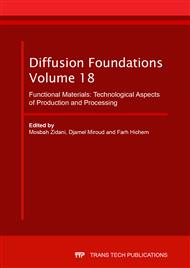[1]
I. Hsanullah, F.A. Al-Khaldi, Basel A. Sharkh, A. M. Abulkibash, T. Laoui. Effect of acid modification on adsorption of hexavalent chromium (Cr (VI)) from aqueous solution by activated carbon and carbon nanotubes. Desalination and Water Treatment, 57 (2016).
DOI: 10.1080/19443994.2015.1021847
Google Scholar
[2]
M. H. Dehghani, D. Sanaei, I. Ali. A. Bhatnagar. Removal of chromium (VI) from aqueous solution using treated waste newspaper as a low-cost adsorbent: Kinetic modeling and isotherm studies. Journal of Molecular Liquids, 215 (2016) 671-679.
DOI: 10.1016/j.molliq.2015.12.057
Google Scholar
[3]
T. A. Khan, M. Nazir, I. Ali, A. Kumar. Removal of Chromium (VI) from aqueous solution using guar gum–nano zinc oxide biocomposite adsorbent. Arabian Journal of Chemistry, 10 (2017) S2388-S2398.
DOI: 10.1016/j.arabjc.2013.08.019
Google Scholar
[4]
Y. Ying, Y. Liu, X. Wang, Y. Mao, W. Cao, P. Hu, X. Peng. Two-Dimensional Titanium Carbide for Efficiently Reductive Removal of Highly Toxic Chromium (VI) from Water. Applied Materials and Interfaces, 7 (3) (2016) 1795–1803.
DOI: 10.1021/am5074722
Google Scholar
[5]
Y. Nakano, M. Tanaka, Y. Nakamira, M. Konno. Removal and recovery system hexavalent chromium from waste water by tannin gel particles. Journal of Chemical Engineering, 33 (2000) 747-752.
DOI: 10.1252/jcej.33.747
Google Scholar
[6]
M. I. Qureshi, F. Patel, N. Al-Baghli, B. Abussaud, B. S. Tawabini, T. Laoui. A Comparative Study of Raw and Metal Oxide Impregnated Carbon Nanotubes for the Adsorption of Hexavalent Chromium from Aqueous Solution. Bioinorganic Chemistry and Applications, 2017 (2017).
DOI: 10.1155/2017/1624243
Google Scholar
[7]
M. Kashifuddin. A review on the adsorption of heavy metals by clay minerals, with special focus on the past decade. Chemical Engineering Journal, 308 (2017) 438-462.
DOI: 10.1016/j.cej.2016.09.029
Google Scholar
[8]
H. Daraei, A. Mittal, M. Noorisepehr, J. Mittal. Separation of chromium from water samples using eggshell powder as a low-cost sorbent: kinetic and thermodynamic studies. Destination and Water Treatment, 53 (2015) 214-220.
DOI: 10.1080/19443994.2013.837011
Google Scholar
[9]
L. Pasti, E. Rodeghero, G. Beltrami, M. Ardit, E. Sarti, T. Chenet, C. Stevanin, A. Martucci. Insights into Adsorption of Chlorobenzene in High Silica MFI and FAU Zeolites Gained from Chromatographic and Diffractometric Techniques. Minerals, 8 (3) (2018) 80.
DOI: 10.3390/min8030080
Google Scholar
[10]
B. Xue, H. Guo, L. Liu, M. Chen. Preparation, characterization and catalytic properties of yttrium-zirconium-pillared montmorillonite and their application in supported catalysts. Clay Minerals. 50 (3) (2015) 211-219.
DOI: 10.1180/claymin.2015.050.2.05
Google Scholar
[11]
Y. Chen, D. An, S. Sun, J. Gao, L. Qian. Reduction and removal of chromium VI in water by powdered activated carbon. Materials, 11 (2018) 269.
DOI: 10.3390/ma11020269
Google Scholar
[12]
S. Deng, Y. Nie, Z. Du, Q. Huang, P. Meng, B. Wang, J. Huang, G. Yu. Enhanced, Adsorption of perfluorooctane sulfonate and perfluorooctanoate by bamboo-derived granular activated carbon. Journal of Hazardous Materials, 282 (2015) 150-157.
DOI: 10.1016/j.jhazmat.2014.03.045
Google Scholar
[13]
M. Fellah, L. Aissani, N. Corinne, M. Abdul Samed and A. Montagne, Transaction of Institute of Metal Finishing, 95 (05) (2017) 261–268.
Google Scholar
[14]
M. Fellah, M. Abdul Samad, M. Labaïz , O. Assala, Sliding friction and wear performance of the nano-bioceramic α-Al2O3 prepared by high energy milling, Tribology International, 91 (2015) 151-159.
DOI: 10.1016/j.triboint.2015.07.006
Google Scholar
[15]
M. Fellah, A. Linda, M. Abdul Samed, A. Montagne. Effect of replacing vanadium by nobium and iron on the tribological behavior of HIPed titanium alloys. Acta Metallurgica Scinica (English letter), 30 (11) (2017).1089-1099.
DOI: 10.1007/s40195-017-0652-x
Google Scholar
[16]
B. Szala, T. Bajda A. Jeleń. Removal of chromium (VI) from aqueous solutions using zeolites modified with HDTMA and ODTMA surfactants. Clay Minerals, 50 (1) (2015) 103-115.
DOI: 10.1180/claymin.2015.050.1.10
Google Scholar
[17]
M. Fellah, L. Aissani, M. Abdul Samad, D. Leila, C. Nouveau, H. Djebaili, A. Montagneg, and A. Iost: Transaction of Institute of Metal Finishing, 96 (2) (2018) 79-85.
DOI: 10.1080/00202967.2018.1424403
Google Scholar
[18]
O. Khireddine, Y. Berredjem, F.Hailaimia, S. Nouacer, R. Djellaibi, N. Bensid, A. Boulmokh. Removal of Para-Nitrophenol by Adsorption on Intercalated Natural Clay. Sensor Letters, 14 (3) (2016) 258-265.
DOI: 10.1166/sl.2016.3647
Google Scholar
[19]
Y. Hu, N. M. Fitzgerald, G. Lv, X. Xing, W. T. Jiang, and Z. Li. Adsorption of Atenolol on Kaolinite. Advances in Materials Science and Engineering, 2015 (2015) 8 pages.
DOI: 10.1155/2015/897870
Google Scholar
[20]
S. M. A. Hamdy. Adsorption of Water Heavy Metals onto Natural Clay Environmental Science. Indian Journal of Applied Research, 5 (1) (2015) 200-202.
Google Scholar
[21]
R. Sharma, D. Sharma. Use of variamine blue dye in spectrophotometric determination of water soluble Cr (VI) in portland cement. Oriental Journal of Chemistry, 31 (2015) 2231-2237.
DOI: 10.13005/ojc/310448
Google Scholar
[22]
P. Maziarz, A. Prokop, J. Matusik. A comparative study on the removal of Pb (II), Zn (II), Cd (II) and As (V) by natural, acid activated and calcinated halloysite. Geology, Geophysics and Environment, 41 (1) (2015) 108–109.
DOI: 10.7494/geol.2015.41.1.108
Google Scholar
[23]
G. A. Kovo, A. D. Folasegun. Acid-modified montmorillonite for sorption of heavy metals from automobile effluent. Journal of Basic and Applied Sciences 5 (1) (2016) 1-12.
Google Scholar
[24]
A. Ihsanullah, A. Amir, M. Al-Amer, T. Laoui, M. Almarri, M. Nasser, M. Khraisheh, M. A. Atieh. Heavy metal removal from aqueous solution by advanced carbon Nanotubes: Critical review of adsorption applications. Separation and Purification Technology, 157 (2016).
DOI: 10.1016/j.seppur.2015.11.039
Google Scholar
[25]
B. Szala, T. Bajda, A. Jelen. Removal of chromium (VI) from aqueous solutions using zeolites modified with HDTMA and ODTMA surfactants. Clay Minerals, 50 (2015) 103–115.
DOI: 10.1180/claymin.2015.050.1.10
Google Scholar


